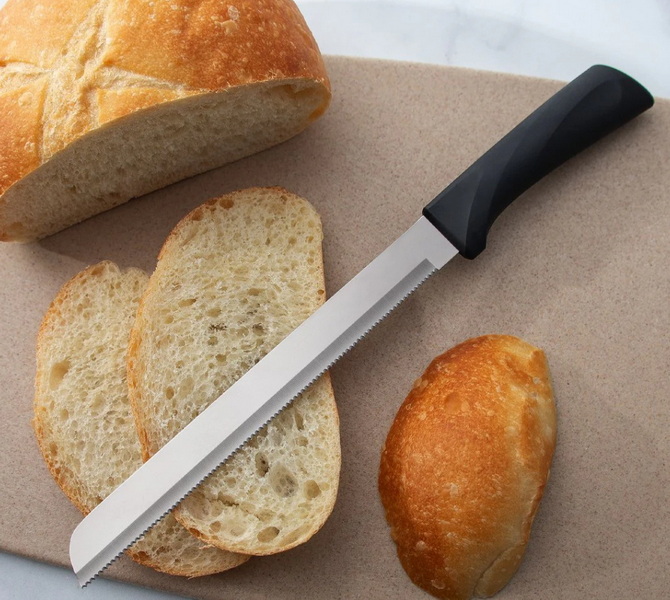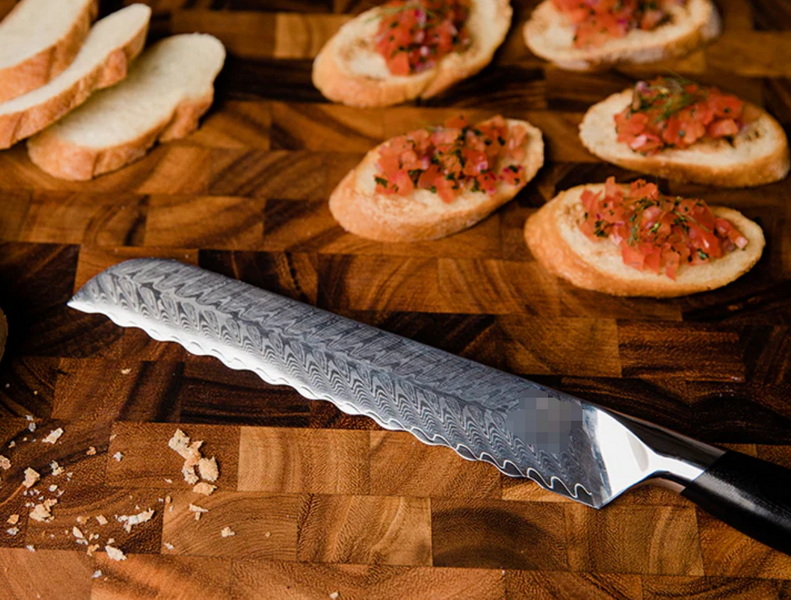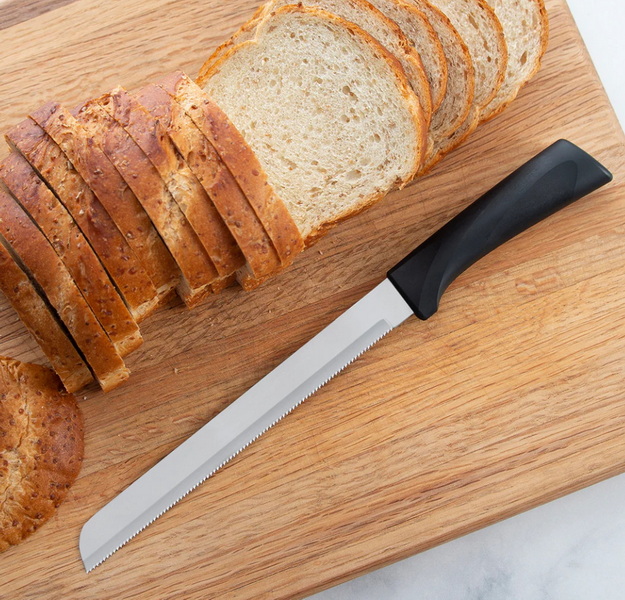- All
- Product Name
- Product Keyword
- Product Model
- Product Summary
- Product Description
- Multi Field Search
Views: 222 Author: Ann Publish Time: 2025-11-04 Origin: Site











Content Menu
>> Serration type and tooth geometry
>> Blade length
● Material choices and edge retention
>> Steel type
>> Coatings and coatings-free blades
● Ergonomics and handle design
>> Weight
● Cleaning, sanitation, and food safety
>> Sanitization and regulatory alignment
● Brand positioning and customization
>> Quality control and consistency
● Market applications and use cases
● Packaging, marketing, and after-sales support
>> Packaging
>> After-sales
● The OEM collaboration pathway
>> Scale-up and supply chain readiness
● FAQs (five or more) with answers
>> Q1: What makes a Bread Knife serrated edge effective for bread?
>> Q2: What blade length is best for typical bread loaves?
>> Q3: Which handle material is ideal for professional use?
>> Q4: How should Bread Knives be sharpened?
>> Q5: What OEM options are available for Bread Knives?
Bread knives are specialized tools that transform crusty loaves into perfectly sliced servings without crushing the soft interior. For OEM partnerships and international buyers, selecting the right Bread Knife involves more than just price. It requires understanding blade geometry, materials, ergonomics, edge retention, and maintenance. This article surveys the critical features that distinguish a great Bread Knife and explains how these elements translate into reliable performance for both home kitchens and professional bakeries. It also highlights considerations relevant to OEM collaborations, including sourcing, customization opportunities, and quality controls that ensure consistent results across global markets.

A Bread Knife's defining characteristic is its serrated blade. The teeth are designed to saw through crusty exteriors with minimal crushing of the crumb, enabling even slices and improved plating. Key blade design elements to evaluate include:
- Classic serrated edges are alternating small and large teeth that grip and cut bread without tearing.
- Dual-sided or scalloped serrations can improve bite-through capability on dense artisanal loaves.
- Common lengths range from 8 to 10 inches (20–25 cm). Longer blades cover larger loaves in a single stroke, while shorter blades offer more control for smaller breads or delicate loaves.
- A thinner blade reduces drag and can glide through crust with less resistance, but must balance with durability, especially in bakery environments.
- Moderate rigidity helps maintain a straight cut without bending or wandering through the loaf.
Why this matters for OEMs: Standardizing a serration profile and blade length across a product line aids in predictable performance, easier replacement parts, and scalable manufacturing. Input from end-users such as bakers and restaurant chefs can guide serration tuning, ensuring compatibility with a wide range of bread textures—from crusty boules to soft sandwich loaves.
The choice of steel and heat treatment directly affects sharpness, durability, corrosion resistance, and maintenance needs. Important considerations include:
- High-carbon stainless steels are common for bread knives, offering a balance of hardness, edge retention, and corrosion resistance.
- Some premium models use laminated or layered steels to combine a hard core with a more ductile exterior, aiding toughness and rust resistance.
- Typical hardness ranges for bread knife blades fall in the mid-50s to low-60s on the Rockwell scale, optimizing edge retention while reducing brittleness.
- Ice-tempering or advanced heat-treatment methods can extend edge life and resist chipping in daily bakery use.
- Minimal or no coating reduces the risk of coating wear and potential flavor transfer to foods.
- Some brands use polished finishes to reduce adhesive crumb buildup and improve release during slicing.
OEM relevance: Material specification must align with procurement cycles, supply chain stability, and regional corrosion expectations (e.g., coastal markets subject to higher humidity). Offering a defined material spec sheet with alternate options allows buyers to tailor the product to their brand promise and price targets.
A comfortable, secure grip is essential for long slicing sessions and precise cuts. Considerations include:
- G10, micarta, pakkawood, or synthetic composites balance grip security with durability and aesthetics.
- Stainless steel handles with ergonomic contours are common for professional environments where sanitation and ease of cleaning matter.
- Curved or contoured tangs, finger guards, and balanced weight distribution reduce fatigue and improve control.
- Smooth surfaces and integrated bolsters minimize crumb collection in crevices, making cleaning easier.
- Dishwasher-safe designs can be a selling point for commercial customers, though direct handwashing may extend blade life.
OEM opportunities: Offer customizable handle scales, logos, and colorways to fit a global brand's visual identity. Provide a range of tang designs (full tang vs partial tang) to accommodate different price points and performance goals.
While serrations handle the primary work, the edge geometry behind the teeth influences overall performance:
- A freshly honed Bread Knife slices cleanly through crust without tearing the crumb. Periodic reglogging or re-sharpening requirements should be stated.
- Provide clear guidelines on sharpening methods compatible with serrated blades, typically using a specialized serrated knife sharpener or professional service.
- Some brands claim extended life due to tooth geometry, while others may require more frequent maintenance in heavy-use environments like bakeries.
OEM note: Include customer-facing maintenance instructions and optional sharpening service plans. Consistency in blade geometry across batches ensures uniform performance and reduces after-sales friction.
The overall feel of a Bread Knife affects daily use:
- Heavier blades can feel substantial and may imply durability, though heavy blades can fatigue the user over long sessions.
- Lighter blades offer precision but can bend under heavy use if not properly engineered.
- A well-balanced knife pivots naturally in the hand, enabling precise, even slicing with less wrist strain.
- The handle length and blade length together determine leverage and control.
OEM considerations: Provide several size options in a product line to cover bakery, restaurant, and consumer markets. Offering a modular handle or interchangeable grip components can help international buyers customize for regional preferences.

Food safety requirements vary by market, but universal hygiene principles apply:
- Stainless components and smooth surfaces minimize bacterial harborage and crumb retention.
- Align with common standards for food-contact surfaces in target regions (e.g., dishwasher safety, corrosion resistance, and nickel release guidelines where applicable).
- Protective blade covers or sheathes help avoid accidents during shipping and storage.
OEM advantage: Provide certified testing data and compliance documentation (e.g., material safety sheets, corrosion ratings, dishwasher compatibility) to reassure international buyers and reduce onboarding friction.
For foreign brands and distributors, the Bread Knife is a canvas for brand storytelling:
- Size tweaking, handle materials, blade finishes, and packaging can align with regional preferences and pricing.
- Standardized production processes, tight tolerances, and batch traceability ensure every unit meets spec, a key selling point for OEM partnerships.
Bread knives are versatile beyond basic bread slicing. Consider expanding the scope in product communications:
- Crusty artisan loaves, sourdough, baguettes, and denser rye breads benefit from serrated teeth that bite through crust without crushing interior.
- Tomatoes, soft fruits, pastries, and delicate cakes can be sliced with careful technique, depending on blade geometry.
- Bakery lines, hotel kitchens, and catering services may demand higher durability and ease of sanitation, influencing feature prioritization.
How a Bread Knife is presented and supported can influence purchase decisions:
- Blister packs, magnetic boxes, or clamshells with tamper-evident seals help communicate quality and protect blades in transit.
- Clear warranty terms, sharpening programs, and replacement part availability help build long-term trust.
For brands seeking OEM partnerships, a structured approach reduces risk and accelerates time to market:
- Define target markets, blade lengths, serration styles, handle materials, finish options, and packaging.
- Establish sample cycles, perform durability and corrosion tests, and collect end-user feedback.
- Provide precise bill of materials (BOM), process standards, QA checklists, and regulatory compliance evidence.
- Plan for mass production, quality assurance, and logistics that meet global distribution needs.
A great Bread Knife is defined by a blend of precise blade geometry, durable materials, ergonomic handling, and clear maintenance guidance. For OEM collaborations, offering standardized yet customizable options helps international brands deliver consistent performance across markets, while meeting diverse consumer expectations. By prioritizing serration quality, edge retention, handle comfort, and sanitation compatibility, partners can deliver a bread-cutting tool that earns lasting trust from professional kitchens and home bakers alike. Contact our OEM team to discuss blade lengths, handle materials, branding, and packaging options that align with your market strategy and quality standards.

- A serrated edge grips and saws through crust while preserving the crumb, enabling even slices without crushing the interior. Bread Knife design emphasizes tooth geometry, blade length, and edge maintenance to optimize performance.
- Common bread knife lengths range from 8 to 10 inches, with longer blades suited for large artisanal loaves and shorter blades offering greater control for smaller breads.
- Ergonomic handles made from materials like G10, micarta, or pakkawood provide secure grip, comfort, and sanitation advantages, with full-tang designs often preferred for durability in busy kitchens.
- Serrated blades typically require specialized serration sharpeners or professional service; follow manufacturer guidance for safety and blade life.
- OEM options include blade length, serration type, blade finish, handle material, color, branding, packaging, and packaging inserts, all designed to meet regional preferences and regulatory requirements.
The Ultimate Professional Knives for Halal Butchery in Middle Eastern Kitchens
Chef Knife Size Guide: Choosing Between 6″, 8″, 10″, And 12″
Custom Knife Handles: How To Design A Chef Knife That Fits Your Hand Perfectly
Chef Knife Surface Treatments Guide: From Polished Migaki To Damascus Patterns
Inside Our Professional Knife Sample Room: Quality You Can See
Universal Knife Block Buying Guide: Modern Acrylic & ABS Knife Holders for Professional Kitchens
Universal Knife Block: The Complete Guide To Modern, Hygienic Knife Storage
The Complete Guide To Red Handle Knife Sets: Style Meets Functionality in The Kitchen
Professional Knives for Halal Butchery And Middle Eastern Cuisine